Adventures in Time and Space... and Science
The BBC television series Doctor Who was first broadcast in November 1963. It has been a continuous cultural presence through original broadcasts, repeats, novels, audio adventures and other spin off media for the sixty years that have elapsed since the first broadcast. While there have been books, and even a television programme, on the science shown in Doctor Who, the relationship between the science fiction series and science is of equal interest.
In 2020, Marcus Harmes and Lindy Orthia edited a collection of essays on “Doctor Who and Science: Essays on Ideas, identities and ideologies in the series”. This focused on specific areas of the representations of science and scientific concepts in the series. I’d recommend it (and not just because of my own chapter on The Moon) but here I’m going to take a bit more of an overview [1] and talk about how the series has interacted with science - or avoided it - over the last six decades.
Scientific Remit and Advisors
Since its foundation in 1922, the BBC has held a remit to inform, educate and entertain. Of course, those three goals may sometimes find themselves in conflict. In particular, fiction may entertain without educating or informing, while education may sometimes prove sadly lacking in entertainment. As a programme aimed for a family-friendly Saturday evening broadcast slot, Doctor Who was designed primarily as entertainment, but at least in part with an educational premise. To this end, the initial plan involved balancing futuristic stories with historical ones (making use of the Doctor’s time machine, the TARDIS), and the Doctor’s first companions included both a history teacher and a science teacher, as well as a young girl to whom information could be explained.
Using science fiction as a way of demonstrating some aspects of science had a precedent in earlier programmes, and in particular in a series made by Doctor Who creator Sydney Newman for the commercial broadcaster ABC television. Target Luna (1960), Pathfinders in Space (1960), Pathfinders on Mars (1960-1) and Pathfinders on Venus (1961) were each multi-episode, half hour science fiction dramas. They followed the efforts of a British team to ensure the first moon landing, the accidental inclusion of his children and a journalist in the spaceflight programme and their trials and tribulations. In each case the stories took extensive liberties with scientific knowledge as it stood at the time (for example reverting to the outdated trope of dinosaurs on Venus, which was already known to be unlikely, and finding the remains of a human from an ancient civilisation on the Moon). However the stories also included frequent and sometimes lengthy digressions into scientific principles and information drawn from then cutting-edge spaceflight, (astro)physics and planetary science. Newman commented on the desire for these series to be educational, and - indeed - the series was also used as part of a psychology experiment to explore how young viewers watched and perceived television programmes.
The same premise - and its flaws - were carried forward into the development of Doctor Who. The early stories mingled extensive didactic ventures into fact with equally extensive excursions into fiction. However unlike the then-feasible, if not yet realised, rocket-driven spaceflight imagined by the Pathfinders series, the premise of Doctor Who and in particular the abilities and mechanisms of the TARDIS pushed the adventures of Doctor Who further from any established historical or scientific reality. This became even more true as the series evolved further from its original premise, more alien races were introduced, and the number of historical stories declined. While stories with a scientifically accurate premise continued to occur, so did many which hinged on not just un-scientific but actively counter-scientific principles [2].
The ambivalent relation between the Doctor Who writing staff and scientific fact is somewhat reflected in the relatively minor role of professional scientists as advisors. While several of the creators of earlier popular British science fictions, such as Dan Dare and Journey Into Space had consulted scientists and futurists for advice and inspiration, there is relatively little acknowledgement of scientific advice in the history of Doctor Who. Many of the (abundant) books about the production and history of the series cover the minutiae of choice of script writers, editors' roles and production decisions in detail, but do not mention scientific advice at all.
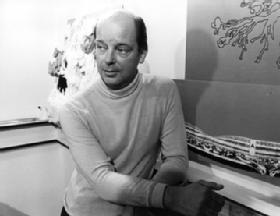 Kit Pedler (who co-created the iconic Cybermen) acted as both a script writer and a scientific advisor to the series production staff, particularly Innis Lloyd and Gerry Davies, in the mid 1960s [3], but he was never formally credited as such on screen. Indeed, his professional scientific experience outside of medicine was relatively limited, although his general knowledge of, and interest in, the field appears to have extended beyond his professional work as a research ophthalmologist. His scripts are notable for their intelligent use of scientific fact, but by the early 1970s he had moved on to other challenges including work on a drama series about scientific ethics that he co-created: Doomwatch.
Kit Pedler (who co-created the iconic Cybermen) acted as both a script writer and a scientific advisor to the series production staff, particularly Innis Lloyd and Gerry Davies, in the mid 1960s [3], but he was never formally credited as such on screen. Indeed, his professional scientific experience outside of medicine was relatively limited, although his general knowledge of, and interest in, the field appears to have extended beyond his professional work as a research ophthalmologist. His scripts are notable for their intelligent use of scientific fact, but by the early 1970s he had moved on to other challenges including work on a drama series about scientific ethics that he co-created: Doomwatch.
Through the seventies and eighties, and again in the 2000s revival, there is little sign of professional scientific advice. Astronomer Edward Gomez is sometimes described as providing (uncredited) scientific advice on some Tenth Doctor stories. However the only formally credited scientific advisor on Doctor Who was zoologist Niall Doran on an episode, “Arachnids in the UK” (2018), that needed specialist information on spiders.
Scientists on Screen
The Doctor is a complex character, whose appearance, character and role have changed as the character “regenerated” and the actor performing the role was recast. Certain of the Doctors, have described themselves explicitly as scientists, although it has been argued that the Doctor’s role is more that of a science advocate or an informed student of science, rather than that of an originator of scientific thought.
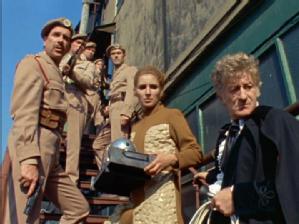 Perhaps the Doctor who most clearly demonstrated the scientific method - developing theories, and undertaking controlled experiments - was Jon Pertwee’s Third Doctor. Perhaps ironically for a series which lacked a clear scientific advisor in its production team for much of its history, the Third Doctor himself was assigned the role as a scientific advisor for the United Nations Intelligence Taskforce (UNIT) in the stories of the early 1970s, and the character resumed this duty intermittently in stories over the decades thereafter. Even as scientific advisor, however, the Doctor was largely focussed on attempts to restore his own TARDIS, or to deal in emergencies with alien incursions, rather than undertaking original scientific research in any particular area. To some extent, this was perhaps inevitable - an alien with advanced scientific knowledge of his own race would face ethical issues regarding contribution to the systematised knowledge development of a more primitive culture.
Perhaps the Doctor who most clearly demonstrated the scientific method - developing theories, and undertaking controlled experiments - was Jon Pertwee’s Third Doctor. Perhaps ironically for a series which lacked a clear scientific advisor in its production team for much of its history, the Third Doctor himself was assigned the role as a scientific advisor for the United Nations Intelligence Taskforce (UNIT) in the stories of the early 1970s, and the character resumed this duty intermittently in stories over the decades thereafter. Even as scientific advisor, however, the Doctor was largely focussed on attempts to restore his own TARDIS, or to deal in emergencies with alien incursions, rather than undertaking original scientific research in any particular area. To some extent, this was perhaps inevitable - an alien with advanced scientific knowledge of his own race would face ethical issues regarding contribution to the systematised knowledge development of a more primitive culture.
By contrast a number of the Doctor’s companions and acquaintances have been explicitly positioned as scientists. Amongst the classic companions (named individuals who travelled with the Doctor on the TARDIS repeatedly over a number of stories), Ian Chesterton was a science teacher, Zoe Heriot was an astrophysicist, Liz Shaw was a multidisciplinary academic research scientist and Peri Brown was a student of botany, while Grace Holloway and Martha Jones were both medical doctors. While the companions were generally shown in a positive light, and their expertise occasionally acknowledged, their scientific achievements tended to be severely overshadowed by the Doctor’s advanced knowledge. Many of the scientists in the series, and the women in particular, were often reduced to screaming dependents.
Along the way, the Doctor and his companions have also met a wide-ranging variety of scientists - mad scientists and sane ones; unethical and ethical, careless and competent scientists; female, male and genderless scientists; human and alien scientists. It’s interesting to note that while there has been a bias towards male scientific contexts and male scientist characters appearing, particularly earlier in the series’ history, studies suggest that where female scientists do appear they are represented as equally competent with their male peers. Along the way there have been some fun moments, from watching the weirdest devices being represented as cutting edge equipment, to learning that reversing the polarity of the neutron flow cures all ills.
Nor has scientific input to the series been entirely ignored. Storylines such as “Logopolis” (1981) - the final adventure of Tom Baker’s Fourth Doctor - pivoted on aspects of computer science and theoretical physics, in this case block transfer calculations, the nature of entropy and vacuum energy, while in “Four to Doomsday” (1982), the Fifth Doctor makes use of Newton’s third law to save himself from a perilous predicament. Other stories have built on contemporary fears over environmental issues, cloning, genetic engineering, exploitative space exploration, climate change and a panoply of issues of scientific ethics.
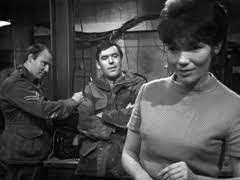 There have also been some interesting character moments. Companion Leela, recruited from a planet where a low-technology warrior tribe has descended from a stranded spaceship crew, gradually comes to accept the Doctor’s scientific viewpoint. As she notes to another character: “I too used to believe in magic, but the Doctor has taught me about science. It is better to believe in science.” (in "Horror of Fang Rock", 1977).
There have also been some interesting character moments. Companion Leela, recruited from a planet where a low-technology warrior tribe has descended from a stranded spaceship crew, gradually comes to accept the Doctor’s scientific viewpoint. As she notes to another character: “I too used to believe in magic, but the Doctor has taught me about science. It is better to believe in science.” (in "Horror of Fang Rock", 1977).
Other characters needed no conversion. When flirted with by a male soldier who asked “What's a girl like you doing in a job like this?”, for example, physicist and electronics engineer Anne Travers notes, “well, when I was a little girl I thought I’d like to be a scientist… so I became a scientist.” (in “The Web of Fear”, 1968). We also see examples of early alchemist-scientists, for whom our contemporary technology is indistinguishable from magic, demonstrating Clarke’s Third Law in their reactions to devices which are familiar to us. This sets the awe shown by the Doctor’s companions for Time Lord metaphysics into an interesting context.
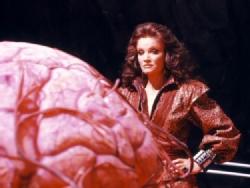 A strikingly interesting example - and object lesson - amongst the occasional scientists who have been encountered more than once in Doctor Who can be found in rogue Time Lady the Rani (portrayed by Kate O’Mara, in “The Mark of the Rani”, 1985, and “Time and the Rani”, 1987). A biochemist, she sets up clear experimental regimens, carries out experiments, records the outcomes and creates theories and further experiments as a consequence of the results. However while her scientific method has some undeniable strong points, she also represents the danger of science without restraint in the series. Originating from the same planet as the Doctor, she left when her experimental methods were found unethical. Given the superior technology of the Time Lords, the Rani considers other sentient races as equivalent to laboratory animals, and justifiable subjects for experimentation - acting as a distorted mirror to human scientific experimental ethics. There are also suggestions that she may fall short in an important aspect of scientific method: refusing to accept evidence that does not fit her preconceived expectations. This failure is a reminder of a memorable quote from the earlier, Fourth Doctor: “You know, the very powerful and the very stupid have one thing in common: they don’t alter their views to fit the facts, they alter the facts to fit their views.”
A strikingly interesting example - and object lesson - amongst the occasional scientists who have been encountered more than once in Doctor Who can be found in rogue Time Lady the Rani (portrayed by Kate O’Mara, in “The Mark of the Rani”, 1985, and “Time and the Rani”, 1987). A biochemist, she sets up clear experimental regimens, carries out experiments, records the outcomes and creates theories and further experiments as a consequence of the results. However while her scientific method has some undeniable strong points, she also represents the danger of science without restraint in the series. Originating from the same planet as the Doctor, she left when her experimental methods were found unethical. Given the superior technology of the Time Lords, the Rani considers other sentient races as equivalent to laboratory animals, and justifiable subjects for experimentation - acting as a distorted mirror to human scientific experimental ethics. There are also suggestions that she may fall short in an important aspect of scientific method: refusing to accept evidence that does not fit her preconceived expectations. This failure is a reminder of a memorable quote from the earlier, Fourth Doctor: “You know, the very powerful and the very stupid have one thing in common: they don’t alter their views to fit the facts, they alter the facts to fit their views.”
Impact and Influence
Despite the somewhat hit-and-miss influence of real-world science on the series, there is no questioning the fact that Doctor Who has had an influence on science in the opposite direction.
Perhaps most obviously, the Doctor Who universe has repeatedly been deployed as a tool for science education. Special Doctor Who material produced for school or home education use has included radio programme Exploration Earth: The Time Machine (1976, featuring the Fourth Doctor and Sarah Jane Smith) as part of a geography module, BBC Schools astronomy programme Search Out Space (1990, featuring the Seventh Doctor and Ace), The Adventure Games and accompanying teacher packs (2010-11) featuring the Eleventh Doctor, the 2013 television lecture The Science of Doctor Who by physicist Brian Cox, The Doctor and the Dalek, a computer game to teach coding with the Twelfth Doctor (2014), and educational resources to accompany Jodie Whittaker’s Thirteenth Doctor (2018).
In addition to the Brian Cox lecture, the television series has generated no fewer than four dedicated “science of” books - The Science of Doctor Who (Parsons, 2006), A Teaspoon and an Open Mind (White, 2006), The Scientific Secrets of Doctor Who (Guerrier & Kukula, 2016) and The Science of Doctor Who (Brake, 2021). It has also motivated factual information content in children’s fiction books and annuals, placing the Doctor’s superscience into a more down-to-Earth context.
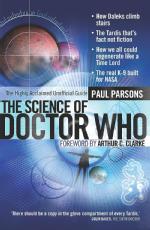 |
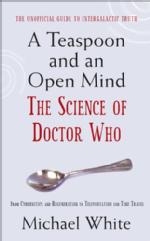 |
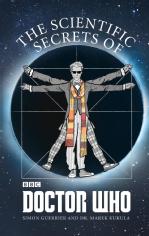 |
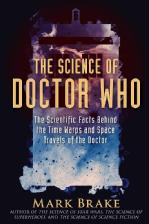 |
Unsurprisingly, perhaps, the series has featured as a draw and a tool for science education in a variety of museum exhibition contexts, perhaps most recently with “Doctor Who Worlds of Wonder” at Liverpool’s World Museum, and with Doctor Who exhibits appearing in the Science Museum’s blockbuster “Science Fiction: Voyage to the Edge of the Imagination”. A significant fraction of self-identified fans of the series have stated that it helped shape their (usually positive) attitudes towards science - although we should note that there is likely a self-selection bias here.
As well as an impact on children’s education and science communication with the public, there is evidence that Doctor Who has had an impact on professional scientists. A number of those who contributed essays to Doctor Who and Science are research scientists who profess a science fiction fandom. More generally, surveys of astronomers suggest Doctor Who (amongst other science fictions) has been an influence on the life and career choices of a substantial fraction of professional astronomers. This is reflected in the appearance of Doctor Who references in research contexts, and the decision to name surface features Gallifrey Macula and Tardis Chasma (amongst other science fiction references) on Pluto’s moon Charon. While it is unlikely that Doctor Who itself has directly inspired specific scientific research projects (although there may be exceptions), it has inspired those who undertake the research - recruiting new minds into scientific careers and having a lasting impact on the sciences, and on astronomy in particular.
Could the science in Doctor Who be better? Certainly.
Is the science often wrong, and frequently misleading? Of course.
And does every scientist love Doctor Who? Of course not. Some, it has to be said, loathe it with a passion.
But nonetheless, a full sixty years after its first broadcast, Doctor Who remains a series capable of exploring the limits of our scientific knowledge, it has contributed to the inspiration of three generations of scientists, and may well help inspire the next generation. This is not a small achievement, and it’s one to be justly celebrated.
“Adventures in Time and Space… and Science”, Elizabeth Stanway, Cosmic Stories blog, 19th November 2023.
Notes:
[1] Just to note that there’s a rich and well-researched academic literature on aspects of the series ranging over the humanities and science disciplines, as well as aspects of audience and popular culture. I can’t hope to do all that justice here, and am not trying to, just to touch on a fairly accessible overview of several fields. I give a very incomplete list of further academic reading below. [Return to Text]
[2] The important distinction here is between things which do not fit anywhere into our current scientific paradigm and might be possible given sufficiently advanced technologies or knowledge (un-scientific), and things which we know flatly simply cannot be true based on readily-testable real-world evidence (counter-scientific). [Return to Text]
[3] The role of Kit Pedler in the series is discussed extensively in Michael Seely’s 2014 biography, The Quest for Pedler, in which a chapter is entitled “The Genial Hokum of Doctor Who”. [Return to Text]
All views expressed here are those of the author and do not necessarily reflect those of the University of Warwick. Images sourced from publicly accessible websites online and used her for review purposes.
Further Reading (Earlier Cosmic Stories blog entries, see also index by works):
Further Reading (Academic):
- Orthia, L. A. (2011). Antirationalist critique or fifth column of scientism? Challenges from Doctor Who to the mad scientist trope. Public Understanding of Science, 20(4), 525–542.
- Wilson, Carl (2015). “Doctor Who and the BBC’s Remit for Education and Information”, CST Online, blog.
- O’Keeffe, M (2017). Riding the wave: Science fiction media fandom and informal science education, Journal of Science Fiction, Vol 1, Number 3
- Orthia, L.A., Morgain, R. (2016). The Gendered Culture of Scientific Competence: A Study of Scientist Characters in Doctor Who 1963–2013. Sex Roles 75, 79–94.
- Orthia, Lindy A. (2019). "How does science fiction television shape fans' relationships to science? Results from a survey of 575 ‘Doctor Who’ viewers." Journal of Science Communication 18.4, A08.
- Orthia, L; Harmes M (2020). Science in Twenties Doctor Who. Doctor Who and Science.
- Stanway, E (2020). Who’s Moon. Doctor Who and Science.
- Harmes, M K (2020). E=mc^3: Doctor Who and Energy. Doctor Who and Science.
- Harmes, M K; Scully, R (2020). Maxtible’s Mirrors: Victorian Science in Classic Era Doctor Who. Doctor Who and Science.
- Sezen, T (2020). The Use and Abuse of Scientific Format in Doctor Who Epistolatory Paratexts. Doctor Who and Science.
- Stack, M (2020). Did the Doctor Change Sex or Gender? Navigating the sex and gender divide in Doctor Who. Doctor Who and Science.
